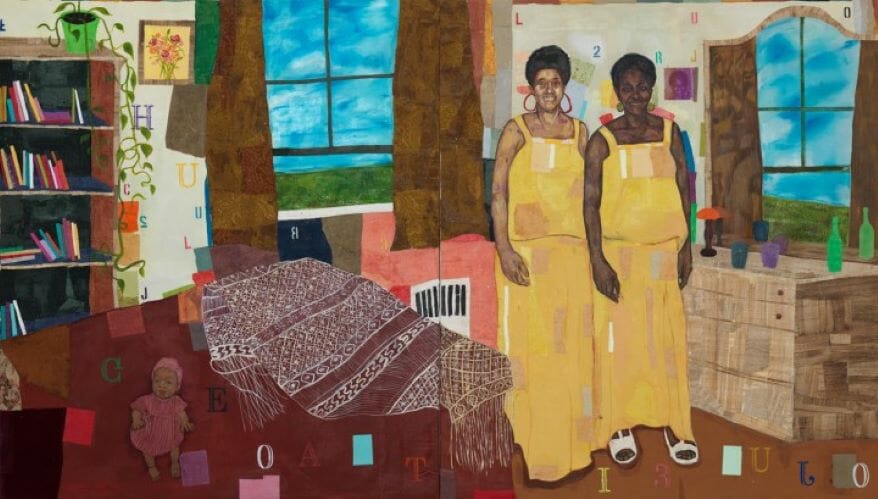Bill Gautreaux Carries on Kansas City’s Legacy of Collecting and Sharing Art 'If you change the way you think, you can change your world.'
Published September 26th, 2023 at 6:00 AM
Above image credit: Bill and Christy Gautreaux with part of their collection inside their home. (Photo | Jim Barcus)Kansas City suffered a major blow when art patrons such as Henry and Marion Bloch and Morton and Estelle Sosland passed away in recent years. Art lovers wondered if anyone would, or could, step up to take their place.
One might argue that the Blochs, the Soslands and others in their league are irreplaceable. But fortunately, Bill and Christy Gautreaux are carrying on Kansas City’s proud legacy of art collecting and philanthropy.
ARTnews named the Gautreauxes among the world’s top 200 art collectors during 2014-18. Bill serves on the boards of trustees of The Nelson-Atkins Museum of Art and Kemper Museum of Contemporary Art, as well as the board of New York-based Art21, which archives living contemporary artist interviews. He also is involved in a wide variety of other nonprofit initiatives.
The Gautreaux art collection is especially attuned to works by artists of color and other underrepresented categories of artists, at a time when museums are diversifying their collections to better reflect their communities.
“He feels deeply about art, about how it is a way to think about the world,” said Julián Zugazagoitia, director and CEO of the Nelson-Atkins. “He collects with a great social consciousness. He has been collecting (the works of) underrepresented artists for the longest time.”
And Gautreaux “has been very generous with us in terms of sharing his collection,” Zugazagoitia noted.
Wendy Guillies, interim CEO of Kemper Museum, said Kansas City is “known as a thriving arts community and destination in the Midwest. With costs on the rise and arts and culture funding making up only approximately five percent of philanthropic gifts, every patron of the arts in this city is crucial. We are grateful for Bill and Christy’s influential leadership, commitment, and generosity in this area.”
Guillies added that the Kemper’s efforts to increase representation of artists from historically excluded backgrounds has been “bolstered by trustees and leaders like Bill who have long shared this priority.”
The Gautreauxes were among the collectors Raechell Smith turned to when she organized the recent “Return the Gaze” exhibition at the H&R Block Artspace at the Kansas City Art Institute. The exhibition focused on the rising prominence of the Black figure in global contemporary art.

“Bill is kind of a quiet and reserved man,” said Smith, the director/curator of the Artspace. “But when we first talked about the exhibition project, he said ‘I really want you to look at this artist, I would really love for you to see this work.’ He allowed me to consider the full spectrum of his collection, and he was incredibly generous.”
The Nerman Museum of Contemporary Art borrowed 10 artworks from the Gautreaux collection for its “Adorned” exhibition, which ran from September 2022 to February 2023.
“The exhibition would not have been anywhere near as successful without the loans from the Gautreaux collection,” said JoAnne Northrup, the Nerman’s executive director and chief curator. “The Gautreauxes made their collection freely available to me and told me I could borrow anything they had on view in their home or in storage. It was a huge boon.”
Outside the museum world, about a dozen loaned artworks from the Gautreaux collection greet employees and visitors at the Greater Kansas City Community Foundation.
“The willingness to share that art with us and all the people who come through these offices is an act of generosity that’s hard to put in words,” said Debbie Wilkerson, the foundation’s president and CEO.

A Lover of Art and a Shrewd Art Investor
In an interview at his home, where every wall is plywood-backed and designed to display art, Bill Gautreaux humbly downplayed his role in the Kansas City art universe.
“I’ve never thought about myself as taking the place of a Henry Bloch or a Mort Sosland or a Donald Hall Sr. or a Crosby Kemper Jr.,” he said. “I think the Kansas City region flies above its weight in the arts.”
However, Gautreaux freely acknowledges his deep feelings for art and the crucial role it plays. “I’m very passionate about it. It’s become a lifelong journey.”
Gautreaux, a Louisiana native who was raised in Oklahoma City, said he “didn’t grow up around art. I didn’t go to museums, unless you count the National Cowboy and Western Heritage Museum in Oklahoma City. But I was always interested in design, the aesthetic of art.”
Gautreaux studied history and philosophy at William Jewell College in Liberty, where he received a Bachelor of Arts degree. He also earned honors from a study program at the University of Oxford in England.
Gautreaux tended bar and gave tennis lessons before landing a part-time telemarketing job at Ferrellgas, a propane supplier based in Liberty, in 1985.
“I worked in the wholesale marketing side of the company, which was in start-up mode,” he said. “I would go through a directory of Propane Gas Association members, look at where they were on the map, call them and try to sell them propane. I’m not sure I always enjoyed it, but it seemed like I had the ability to do it.”
Gautreaux rose through the ranks of the energy industry, co-founding two start-up companies. He became chief marketing officer and president of Crestwood Midstream Partners following its merger with Inergy LP in Kansas City.
He exited the business in 2017 to start a new chapter. This has included more travel time with family, private investments/art collecting, and work on civic and nonprofit leadership activities.
“I’ve approached art collecting like the way I’ve always approached business,” he said. “I was always passionate about it. I was trying to build something. I was involved in buying and selling and risk management. Art is an investment and a tradeable asset. There’s a lot of research you need to do to track and follow values in art. That is a skill set very much like what I employed in the propane gas industry.”

Gautreaux started investing in art around 2007. He said he “quickly understood that I was never going to be able to afford pre- and post-war modern art, because it was too expensive. That got me thinking about earlier stage emerging artists and categories of artists that have been overlooked, such as Black artists, women artists, and international artists who weren’t well known in the U.S.”
The “bias of the museum world and the bias of curatorial professionals has resulted in a focus on white male artists,” Gautreaux said. “It’s a huge oversight on the part of the art world. After gaining ground over the last five years, Black and women artists still only make up a low single-digit percentage of artwork sold at auction. This trend is still early.”
Gautreaux’s home plays host to approximately 150 artworks. About 40% were created by Black artists and another 40% by women artists, with the rest credited to artists identifying as Latin American, Indigenous, LGBTQ+, or otherwise international.
“Artists to me are like entrepreneurs,” he said. “Some of them are maybe more social entrepreneurs, but they’re all entrepreneurs. I have an affinity for people who are trying to start something up.”
In addition to the value proposition of collecting such artworks, Gautreaux said seeking out works by overlooked artists has exposed him to new ideas and new ways of seeing the world.
“It’s changed the way I think about things,” he said. “If you change the way you think, you can change your world. It’s important to acknowledge and respect many cultures, things that have happened in our country and across the globe, the era of slavery and Civil War and World Wars. It has helped me understand how complex the world is, and the challenge of all these systemic issues that are a function of our history. Art has helped me navigate all of that.”
Gautreaux said investing in art has “explosive potential” but has been “relegated to a small group of people over the course of history. I think that’s ripe for disruption. If more people were encouraged to look at art as an investment, then more people could justify acquiring art and our collector base would grow and diversify.”
Someone looking to invest in the works of an artist should make a careful evaluation, Gautreaux said. “What are their credentials? Where are they going to art school? What is the unique process they’re bringing to the work they’re making? How are they involved in the gallery system? Are museums interested in acquiring and exhibiting their work?”
He said “that whole system is also ripe for disruption, but it is the system we work in now. And it can be a great indicator of what the investment potential is.”
Looking toward the future, Gautreaux said he would hate to see Kansas City’s arts universe “become complacent because of the largess of historical philanthropists and art collectors. Why don’t we double down on our advantage, and use that to become all that we can be, a center of excellence for the art world? It’s very important to continue that process of pushing the ecosystem, and making sure our art institutions are changing at the rate the world is changing.”
Flatland contributor Julius A. Karash is a Kansas City-based writer. This article first appeared in KC Studio. It is part of an ongoing content collaboration between Flatland and KC Studio.



